An Evaluation of Smartphone Tracking for Travel Behavior Studies
Abstract
:1. Introduction
- -
- During the recruitment of participants, one would expect smartphone tracking to make people more willing to participate in surveys, given the innovative nature and reduced burden;
- -
- In the data collection phase, one would expect that participants entering the smartphone tracking survey are much more likely to complete the data collection period, given the reduced burden compared to paper trip diaries;
- -
- More detailed and more complete registration is expected to result in more reliable indicator values for travel behavior indicators.
2. Materials and Methods
- In the “survey” mode, the participant manually initiates and terminates the registration of a trip at the start and upon arrival. In this case, the user also immediately enters the transport mode and purpose of the specific trip, resulting in complete and reliable trip information (see Figure 1);
- The “background” mode applies automatic trip detection in order to decide autonomously about the activation and deactivation of smartphone tracking, without need of the participant to interfere with the app. In this case, the transport mode is estimated during the processing of the data (out of four modes: pedestrian, bike, motorized and other), resulting in segmented trip activity (time and estimated distance) with one out of four detected transport modes. Trip segments belonging to one trip are recorded as such. In the background mode, no information about trip purpose is available.
- Trips or trip legs with a distance = 0;
- Trips or trip legs with Duration ≤ 0;
- Trips or trip legs with distance < 100 m;
- Trips or trip legs with distance > 100 km.
- The recruitment of the participants;
- The completion rate of the survey;
- The impact of smartphone tracking on the resulting travel behavior indicators.
- Trip rates;
- Modal split;
- Trip purpose;
- Trip distance;
- Trip durations.
3. Results and Discussion
3.1. Recruitment of Participants
3.2. Completion Rate of the Survey
3.2.1. Number of Days with Trip Data
3.2.2. Use of the CONNECT Survey Mode and Correction Option
- The survey mode allows users to manually record their trip during travel, resulting in a higher accuracy in terms of location data as GPS logging is activated during travel;
- Direct feedback on trip details by the user is enabled through the travel diary option in the CONNECT app, providing users with an overview of their weekly travels, where trip data can be edited by correcting errors in detected trip information (e.g., travel mode) or by adding additional information (e.g., trip purpose). In this case, edited information is stored in the database as a “trip revision” and stored next to the original data, so that modifications are traceable.
3.3. Travel Behavior Indicators
3.3.1. Trip Rate
3.3.2. Trip Distances
3.3.3. Trip Durations
3.3.4. Trip Purposes
3.3.5. Modal Split
3.3.6. Comparability of the Indicators between the Surveys
4. Conclusions
- -
- It is important to be aware of the challenge of recruiting participants. The reduced burden on the user does not result in the anticipated increased willingness to participate. Dedicated communication or even campaigning is required to attract and motivate interested candidates. As described in [73], “it was also learned that deploying a smartphone application as a tool for collecting travel data required more support than expected. It is similar to launching a product, which should involve a multidisciplinary team, not only designers of the questionnaire and support system, but also for example staff making the interface more user-friendly”;
- -
- Once participants had entered the survey, however, we observed a higher willingness to complete the survey. Whereas in MOBWAL, only 29% of the participants completed the requested 3-day survey period, in GPSWAL, 83% registered at least 3 survey days and 69% even registered 7 or more days. The reduced burden leads to a more efficient execution of the survey and offers opportunities to perform longer survey periods;
- -
- As the methodology affects indicators’ values based on the survey, it is essential to document in detail the full process of data collection, data processing and data analysis, delivering reproducible results. These aspects need to be taken into account when describing or comparing results from different studies. Also, Prelipcean [78] and Bonnel [79] raise the issue of a lack of transparency and standardization when using (semi-)automated travel diary collection systems and the inability to understand and compare results and performances between systems or methods;
- -
- In order to account for these methodological differences, a combined approach of both written trip diaries and smartphone tracking is advised such that each method can complement the shortcomings of the other. Smartphone tracking has strong assets in terms of quality (exact locations, distance, duration, etc.) and period of the trip registrations but has its limitations in terms of trip characteristics (trip purpose or transport mode need to be inferred from sensor data). These aspects are better covered via trip diaries which, in return, are more laborious for participants. As applied in the GPSWAL test, the annotation of trip characteristics can also be integrated in smartphone apps but this increases the burden on users. The combined approach can contribute to improved insight on the exact methodological impact. Bradley [41] suggests that this combined approach can be used to transition gradually from diary-based to (more) smartphone-based methods across years.
Author Contributions
Funding
Data Availability Statement
Acknowledgments
Conflicts of Interest
References
- Ettema, D.; Timmermans, H.; Van Veghel, L. Effects of Data Collection Methods in Travel and Activity Research; European Institute of Retailing and Service Studies (EIRASS): Eindhoven, The Netherlands, 1996. [Google Scholar]
- Stopher, P.R.; Greaves, S.P. Household travel surveys: Where are we going? Transp. Res. Part A Policy Pract. 2007, 41, 367–381. [Google Scholar] [CrossRef]
- Wolf, J.; Hallmark, S.; Oliveira, M.; Guensler, R.; Sarasua, W. Accuracy issues with route choice data collection by using global positioning system. Transp. Transp. Res. Rec. 1999, 1660, 66–74. [Google Scholar] [CrossRef]
- Clifton, K.; Muhs, C. Capturing and Representing Multimodal Trips in Travel Surveys. Transp. Res. Rec. J. Transp. Res. Board 2012, 2285, 74–83. [Google Scholar] [CrossRef]
- Wolf, J.; Guensler, R.; Bachman, W. Elimination of the travel diary: Experiment to derive trip purpose from Global Positioning System travel data. Transp. Res. Rec. 2001, 1768, 125–134. [Google Scholar] [CrossRef] [Green Version]
- Hato, E.; Shinji, I.; Mitani, T. Development of MoALs (Mobile Activity Loggers supported by GPSphones) for travel behavior analysis. In Proceedings of the 85th Annual Meeting of the Transportation Research Board, Washington, DC, USA, 22–26 January 2006. [Google Scholar]
- Arentze, T.; Dijst, M.; Dugundji, E.; Joh, C.H.; Kapoen, L.; Krygsman, S.; Maat, K.; Timmermans, H. New activity diary format: Design and limited empirical evidence. Transp. Res. Rec. 2001, 1768, 79–88. [Google Scholar] [CrossRef]
- Forrest, T.; Pearson, D. Comparison of Trip Determination Methods in Household Travel Surveys Enhanced by a Global Positioning System. Transp. Res. Rec. 2005, 1917, 63–71. [Google Scholar] [CrossRef]
- Wolf, J.; Oliveira, M.; Thompson, M. Impact of Underreporting on Mileage and Travel Time Estimates: Results from Global Positioning System-Enhanced Household Travel Survey. Transp. Res. Rec. 2003, 1854, 189–198. [Google Scholar] [CrossRef]
- Itoh, S.; Hato, E. Combined estimation of activity generation models incorporating unobserved small trips using probe person data. J. East. Asia Soc. Transp. Stud. 2013, 10, 525–537. [Google Scholar]
- Sammer, G.; Gruber, C.; Roeschel, G.; Tomschy, R.; Herry, M. The dilemma of systematic underreporting of travel behavior when conducting travel diary surveys—A meta-analysis and methodological considerations to solve the problem. Transp. Res. Procedia 2018, 32, 649–658. [Google Scholar] [CrossRef]
- De Abreu E Silva, J.; Davis, M. Workshop synthesis: Respondent/survey interaction in a world of web and smartphone apps. Transp. Res. Procedia 2015, 11, 289–296. [Google Scholar] [CrossRef]
- Bonnel, P.; Bayart, C.; Smith, B. Workshop synthesis: Comparing and combining survey modes. Transp. Res. Procedia 2015, 11, 108–117. [Google Scholar] [CrossRef]
- Schönfelder, S.; Axhausen, K.W.; Antille, N.; Bierlaire, M. Exploring the potentials of automatically collected GPS data for travel behavior analysis: A Swedish data source. In GI-Technologien für Verkehr und Logistik; No. 13; Möltgen, J., Wytzisk, E., Eds.; Universität Munster: Munster, Germany, 2002; pp. 155–179. [Google Scholar]
- Schlich, R.; Axhausen, K.W. Habitual travel behaviour: Evidence from a six-week travel diary. Transportation 2003, 30, 13–36. [Google Scholar] [CrossRef]
- Steer, D.G. The Use of GPS to Improve Travel Data; Study Report for the DTLR New Horizons Programme; London Department for Transport: London, UK, 2003. [Google Scholar]
- Ohmori, N.; Nakazato, M.; Harata, N. Gps mobile phone-based activity diary survey. Proc. East. Asia Soc. Transp. Stud. 2005, 5, 1104–1115. [Google Scholar]
- Tsui, A. Shalaby Enhanced system for link and mode identification for personal travel surveys based on global positioning systems. Transp. Res. Rec. J. Transp. Res. Board 2006, 1972, 38–45. [Google Scholar] [CrossRef]
- Stopher, P.R.; Collins, A. Conducting a GPS prompted recall survey over the internet. In Proceedings of the Transportation Research Board 84th Annual Meeting, Washington, DC, USA, 9–13 January 2005. [Google Scholar]
- Asakura, Y.; Hato, E. Tracking survey for individual travel behaviour using mobile communication instruments. Transpl. Res. Part C Emerg. Technol. 2004, 12, 273–291. [Google Scholar] [CrossRef]
- Axhausen, K.W.; Schönfelder, S.; Wolf, J.; Oliveira, M.; Samaga, U. 80 weeks of GPS-traces: Approaches to enriching the trip information. Transp. Res. Rec. 2003, 178, 46–56. [Google Scholar]
- Du, J.; Aultman-Hall, L. Increasing the accuracy of trip rate information from passive multi-day GPS travel datasets: Automatic trip end identification issues. Transp. Res. Part A Policy Pract. 2007, 41, 220–232. [Google Scholar] [CrossRef]
- Stopher, P.R.; Clifford, E.; Zhang, J. Deducing Mode and Purpose from GPS Data; Working paper; Institute of Transport and Logistics Studies, University of Sydney: Camperdown, Australia, 2008. [Google Scholar]
- Bohte, W.; Maat, K. Deriving and validating trip purposes and travel modes for multi-day GPS-based travel surveys: A large-scale application in the Netherlands. Transp. Res. Part C Emerg. Technol. 2009, 17, 285–297. [Google Scholar] [CrossRef]
- Gong, H.; Chen, C.; Bialostozky, E.; Lawson, C.T. A GPS/GIS method for travel mode detection in New York City. Comput. Environ. Urban Syst. 2012, 36, 131–139. [Google Scholar] [CrossRef]
- Hato, E. Development of behavioral context addressable loggers in the shell for travel-activity analysis. Transp. Res. Part C Emerg. Technol. 2010, 18, 55–67. [Google Scholar] [CrossRef]
- Primerano, F.; Taylor, M.A.P.; Pitaksringkarn, L.; Tisato, P. Defining and understanding trip chaining behaviour. Transportation 2008, 35, 55–72. [Google Scholar] [CrossRef]
- Chen, C.; Gong, H.; Lawson, C.; Bialostozky, E. Evaluating the feasibility of a passive travel survey collection in a complex urban environment: Lessons learned from the New York City case study. Transp. Res. Part A Policy Pract. 2010, 44, 830–840. [Google Scholar] [CrossRef]
- Gadziński, J. Perspectives of the use of smartphones in travel behaviour studies: Findings from a literature review and a pilot study. Transp. Res. Part C Emerg. Technol. 2018, 88, 74–86. [Google Scholar] [CrossRef]
- Vlassenroot, S.; Gillis, D.; Bellens, R.; Gautama, S. The use of smartphone applications in the collection of travel behaviour data. Int. J. Intell. Transp. Syst. Res. 2015, 13, 17–27. [Google Scholar] [CrossRef]
- Nitsche, P.; Widhalm, P.; Breuss, S.; Maurer, P. A Strategy on How to Utilize Smartphones for Automatically Reconstructing Trips in Travel Surveys. Procedia-Soc. Behav. Sci. 2012, 48, 1033–1046. [Google Scholar] [CrossRef] [Green Version]
- Auld, J.; Williams, C.; Mohammadian, A.; Nelson, P. An Automated GPS-Based Prompted Recall Survey with Learning Algorithms. Transp. Lett. Int. J. Transp. Res. 2009, 1, 59–79. [Google Scholar] [CrossRef]
- Zhou, J.; Golledge, R. Real-time tracking of activity scheduling/schedule execution within a unified data collection framework. Transp. Res. A 2007, 41, 444–463. [Google Scholar] [CrossRef] [Green Version]
- Lawson, C.T.; Krans, E.; Rentz, E.G.; Lynch, J. Emerging trends in household travel survey programs. Soc. Sci. Humanit. Open 2023, 7, 100466. [Google Scholar] [CrossRef]
- Harding, C.; Imani, A.F.; Srikukenthiran, S.; Miller, E.J.; Habib, K.N. Are we there yet? Assessing smartphone apps as full-fledged tools for activity-travel surveys. Transportation 2021, 48, 2433–2460. [Google Scholar] [CrossRef]
- Feng, T.; Timmermans, H.J.P. Transportation mode recognition using GPS and accelerometer data. Transp. Res. Part C Emerg. Technol. 2013, 37, 118–130. [Google Scholar] [CrossRef]
- Geurs, K.T.; Thomas, T.; Bijlsma, M.; Douhou, S. Automatic trip and mode detection with move smarter: First results from the Dutch Mobile Mobility Panel. Transp. Res. Procedia 2015, 11, 247–262. [Google Scholar] [CrossRef]
- Harding, C. From Smartphone Apps to In-Person Data Collection: Modern and Cost-Effective Multimodal Travel Data Collection for Evidence-Based Planning; University of Toronto: Toronto, ON, Canada, 2019; p. 554. [Google Scholar]
- Van Gheluwe, C.; Lopez, A.J.; Gautama, S. Error Sources in the Analysis of Crowdsourced Spatial Tracking Data. In Proceedings of the 2019 IEEE International Conference on Pervasive Computing and Communications Workshops (PerCom Workshops), Kyoto, Japan, 11–15 March; 2019; pp. 183–188. [Google Scholar] [CrossRef] [Green Version]
- Yue, Y.; Lan, T.; Yeh, A.G.O.; Li, Q.Q. Zooming into individuals to understand the collective: A review of trajectory-based travel behaviour studies. Travel Behav. Soc. 2014, 1, 69–78. [Google Scholar] [CrossRef]
- Bradley, M.; Greene, E.; Spitz, G.; Coogan, M.; McGuckin, N. The millennial question: Changes in travel behaviour or changes in survey behaviour? Transp. Res. Procedia 2018, 32, 291–300. [Google Scholar] [CrossRef]
- Shen, L.; Stopher, P.R. Review of GPS travel survey and GPS data-processing methods. Transp. Rev. 2014, 34, 316–334. [Google Scholar] [CrossRef]
- Prelipcean, A.C.; Yamamoto, T. Workshop Synthesis: New developments in travel diary collection systems based on smartphones and GPS receivers. Transp. Res. Procedia 2018, 32, 119–125. [Google Scholar] [CrossRef]
- Joseph, L.; Neven, A.; Martens, K.; Kweka, O.; Wets, G.; Janssens, D. Measuring individuals’ travel behaviour by use of a GPS-based smartphone application in Dar es Salaam, Tanzania. J. Transp. Geogr. 2020, 88, 102477. [Google Scholar] [CrossRef]
- Okmi, M.; Por, L.Y.; Ang, T.F.; Ku, C.S. Mobile Phone Data: A Survey of Techniques, Features, and Applications. Sensors 2023, 23, 908. [Google Scholar] [CrossRef]
- Broach, J.; Dill, J.; Gliebe, J. Where do cyclists ride? A route choice model developed with revealed preference GPS data. Transp. Res. Part A Policy Pract. 2012, 46, 1730–1740. [Google Scholar] [CrossRef]
- Lopez, A.J.; Astegiano, P.; Gautama, S.; Ochoa, D.; Tampère, C.M.J.; Beckx, C. Unveiling e-bike potential for commuting trips from GPS traces. ISPRS Int. J. Geo-Inf. 2017, 6, 190. [Google Scholar] [CrossRef] [Green Version]
- Gillis, D.; Gautama, S.; van Gheluwe, C.; Semanjski, I.; Lopez, A.; Lauwers, D. Measuring delays for bicycles at signalized intersections using smartphone GPS tracking data. ISPRS Int. J. Geo-Inf. 2020, 9, 174. [Google Scholar] [CrossRef] [Green Version]
- Poliziani, C.; Rupi, F.; Schweizer, J.; Saracco, M.; Capuano, D. Cyclist’s waiting time estimation at intersections, a case study with GPS traces from Bologna. Transp. Res. Procedia 2022, 62, 325–332. [Google Scholar] [CrossRef]
- Klar, B. Understanding Changes to Human Mobility Patterns in Ontario, Canada during the COVID-19 Pandemic. Master’s Thesis, The University of Western Ontario, London, ON, Canada, 2022. [Google Scholar]
- Ciriaco, T.G.M.; Pitombo, C.S.; Assirati, L. Travel behavior and activity resilience regarding the COVID-19 pandemic in Brazil: An approach based on smartphone panel data. Case Stud. Transp. Policy 2022, 12, 100998. [Google Scholar] [CrossRef]
- Richard, O.; Rabaud, M. French household travel survey: The next generation. Transp. Res. Procedia 2018, 32, 383–393. [Google Scholar] [CrossRef]
- Nour, A.; Hellinga, B.; Casello, J. Classification of automobile and transit trips from Smartphone data: Enhancing accuracy using spatial statistics and GIS. J. Transp. Geogr. 2016, 51, 36–44. [Google Scholar] [CrossRef]
- Lee, J.S.; Zegras, P.C.; Zhao, F.; Kim, D.; Kang, J. Testing the Reliability of a Smartphone-Based Travel Survey: An Experiment in Seoul. J. Korea Inst. Intell. Transp. Syst. 2016, 15, 50–62. [Google Scholar] [CrossRef]
- Eftekhari, H.R.; Ghatee, M. An inference engine for smartphones to preprocess data and detect stationary and transportation modes. Transp. Res. Part C Emerg. Technol. 2016, 69, 313–327. [Google Scholar] [CrossRef]
- Sato, Y.; Maruyama, T. Examining difference between paper- and web-based self-reported departure/arrival time using smartphone-based survey. Transp. Res. Procedia 2020, 48, 1390–1400. [Google Scholar] [CrossRef]
- Nahmias-Biran, B.; Han, Y.; Bekhor, S.; Zhao, F.; Zegras, C.; Ben-Akiva, M. Enriching Activity-Based Models using Smartphone-Based Travel Surveys. Transp. Res. Rec. J. Transp. Res. Board 2018, 2672, 280–291. [Google Scholar] [CrossRef]
- Hong, S.; Zhao, F.; Livshits, V.; Gershenfeld, S.; Santos, J.; Ben-Akiva, M. Insights on data quality from a large-scale application of smartphone-based travel survey technology in the Phoenix metropolitan area, Arizona, USA. Transp. Res. Part A Policy Pract. 2021, 154, 413–429. [Google Scholar] [CrossRef]
- Roddis, S.; Winter, S.; Zhao, F.; Kutadinata, R. Respondent preferences in travel survey design: An initial comparison of narrative, structured and technology-based travel survey instruments. Travel Behav. Soc. 2019, 16, 1–12. [Google Scholar] [CrossRef]
- Assemi, B.; Jafarzadeh, H.; Mesbah, M.; Hickman, M. Participants’ perceptions of smartphone travel surveys. Transp. Res. Part F Traffic Psychol. Behav. 2018, 54, 338–348. [Google Scholar] [CrossRef] [Green Version]
- Hubert, J.; Toint, P. La Mobilité Quotidienne des Belges; Groupe de Recherche sur les Transports, FUNDP University: Namur, Belgium, 2003. [Google Scholar]
- Cornelis, E. La Mobilité en Belgique en 2010: Résultats de L’enquête BELDAM; SPF Mobilité & Transports: Bruxelles, Brussels, 2012. [Google Scholar]
- Service Public Fédéral Mobilité et Transports. Enquête MONITOR sur la Mobilité des Belges; Bruxelles Mobilité: Bruxelles, Belgium, 2017. [Google Scholar]
- Lopez, A.J.; Semanjski, I.; Gautama, S.; Ochoa, D. Assessment of Smartphone Positioning Data Quality in the Scope of Citizen Science Contributions. Mob. Inf. Syst. 2017, 2017. [Google Scholar] [CrossRef] [Green Version]
- Aguirre, A.J.L. Processing Crowdsourced Data for the Analysis of Mobility Behaviour; Ghent Universtiy: Ghent, Belgium, 2018. [Google Scholar]
- CBS Onderzoek Verplaatsingen in Nederland 2017—Onderzoeksbeschrijving. 2018. Available online: https://easy.dans.knaw.nl/ui/datasets/id/easy-dataset:61643 (accessed on 1 March 2023).
- Chlond, B.; Streit, T.; Abler, G.; Vortisch, P. Balancing innovation and continuity-Experiences with survey design adaptations of the German mobility panel. Transp. Res. Procedia 2015, 11, 43–59. [Google Scholar] [CrossRef] [Green Version]
- Silvano, A.P.; Eriksson, J.; Henriksson, P. Comparing respondent characteristics based on different travel survey data collection and respondent recruitment methods. Case Stud. Transp. Policy 2020, 8, 870–877. [Google Scholar] [CrossRef]
- Van Acker, V.; Van Wee, B.; Witlox, F. When Transport Geography Meets Social Psychology: Toward a Conceptual Model of Travel Behaviour. Transp. Rev. 2010, 30, 219–240. [Google Scholar] [CrossRef] [Green Version]
- Prillwitz, J.; Barr, S. Moving towards sustainability? Mobility styles, attitudes and individual travel behaviour. J. Transp. Geogr. 2011, 19, 1590–1600. [Google Scholar] [CrossRef]
- Feng, J.; Dijst, M.; Wissink, B.; Prillwitz, J. The impacts of household structure on the travel behaviour of seniors and young parents in China. J. Transp. Geogr. 2013, 30, 117–126. [Google Scholar] [CrossRef]
- Oakil, A.T.M.; Manting, D.; Nijland, H. Determinants of car ownership among young households in the Netherlands: The role of urbanisation and demographic and economic characteristics. J. Transp. Geogr. 2016, 51, 229–235. [Google Scholar] [CrossRef] [Green Version]
- Allström, A.; Kristoffersson, I.; Susilo, Y. Smartphone based travel diary collection: Experiences from a field trial in Stockholm. Transp. Res. Procedia 2017, 26, 32–38. [Google Scholar] [CrossRef]
- Cornelis, E. La Mobilité en Belgique en 2010: Résultats de L’enquête BELDAM; Groupe de Recherche sur les Transports, FUNDP University: Namur, Belgium, 2012. [Google Scholar]
- Montini, L.; Prost, S.; Schrammel, J.; Rieser-Schüssler, N.; Axhausen, K.W. Comparison of travel diaries generated from smartphone data and dedicated GPS devices. Transp. Res. Procedia 2015, 11, 227–241. [Google Scholar] [CrossRef] [Green Version]
- Maruyama, T.; Sato, Y.; Nohara, K.; Imura, S. Increasing smartphone-based travel survey participants. Transp. Res. Procedia 2015, 11, 280–288. [Google Scholar] [CrossRef]
- Bricka, S.G.; Sen, S.; Paleti, R.; Bhat, C.R. An analysis of the factors influencing differences in survey-reported and GPS-recorded trips. Transp. Res. Part C Emerg. Technol. 2012, 21, 67–88. [Google Scholar] [CrossRef] [Green Version]
- Prelipcean, A.C.; Susilo, Y.O.; Gidófalvi, G. Collecting travel diaries: Current state of the art, best practices, and future research directions. Transp. Res. Procedia 2018, 32, 155–166. [Google Scholar] [CrossRef]
- Bonnel, P.; Munizaga, M.A. Transport survey methods-in the era of big data facing new and old challenges. Transp. Res. Procedia 2018, 32, 1–15. [Google Scholar] [CrossRef]
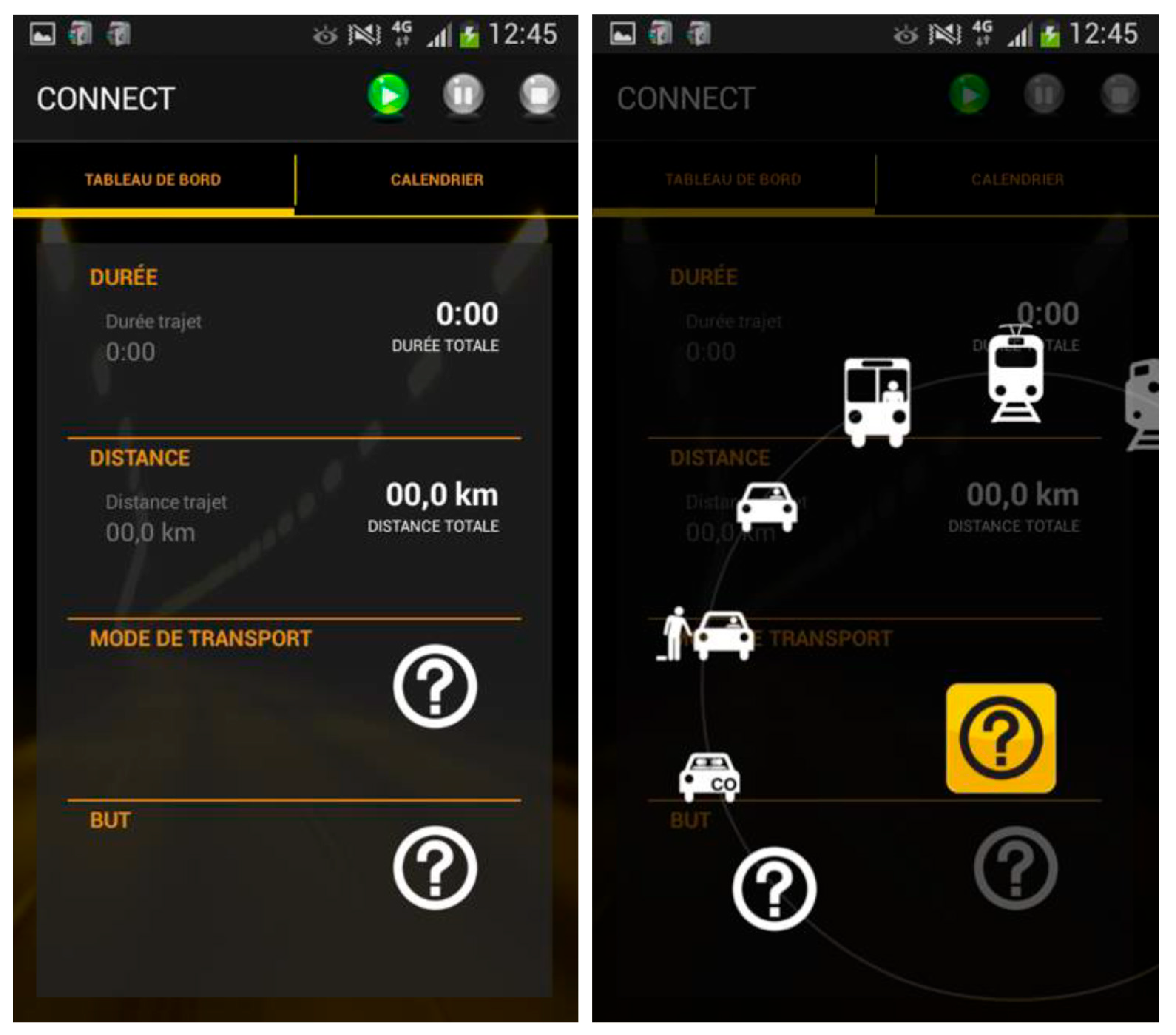

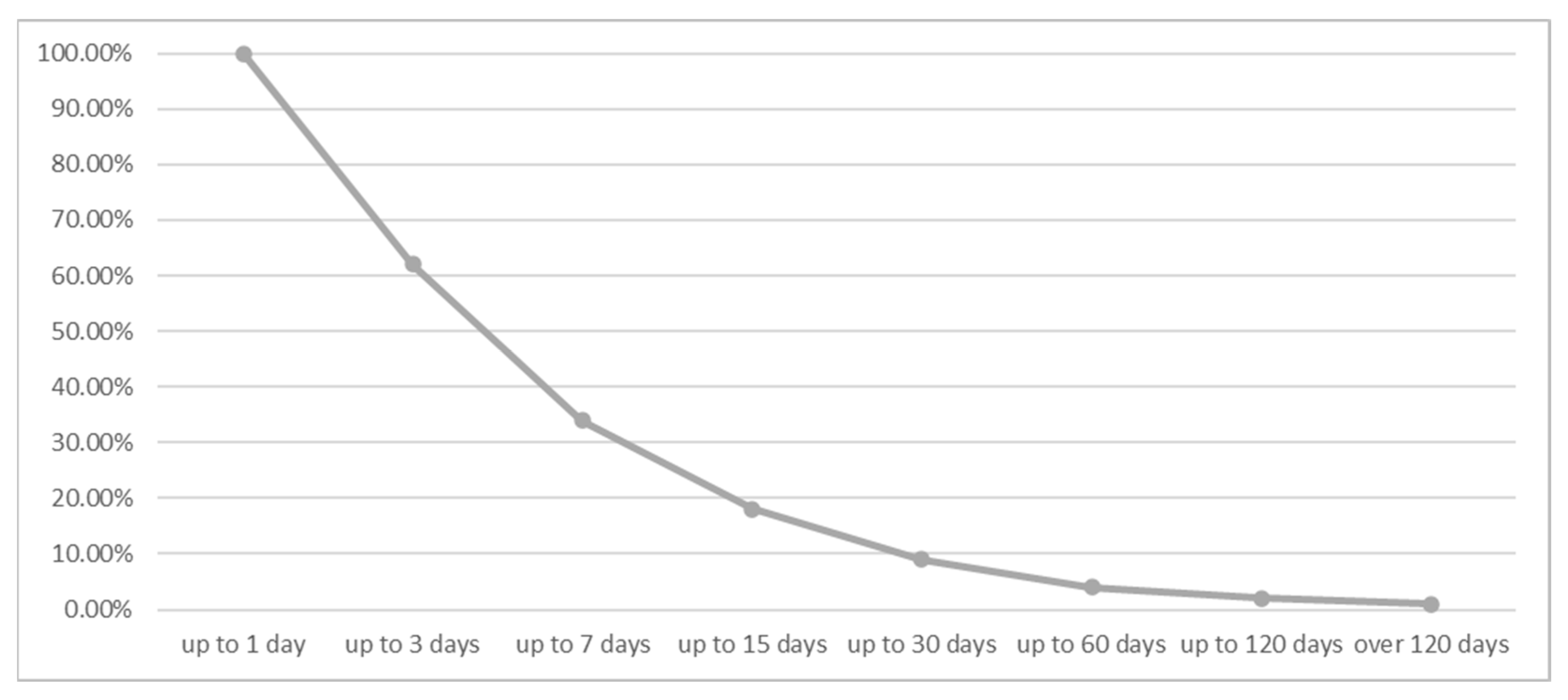
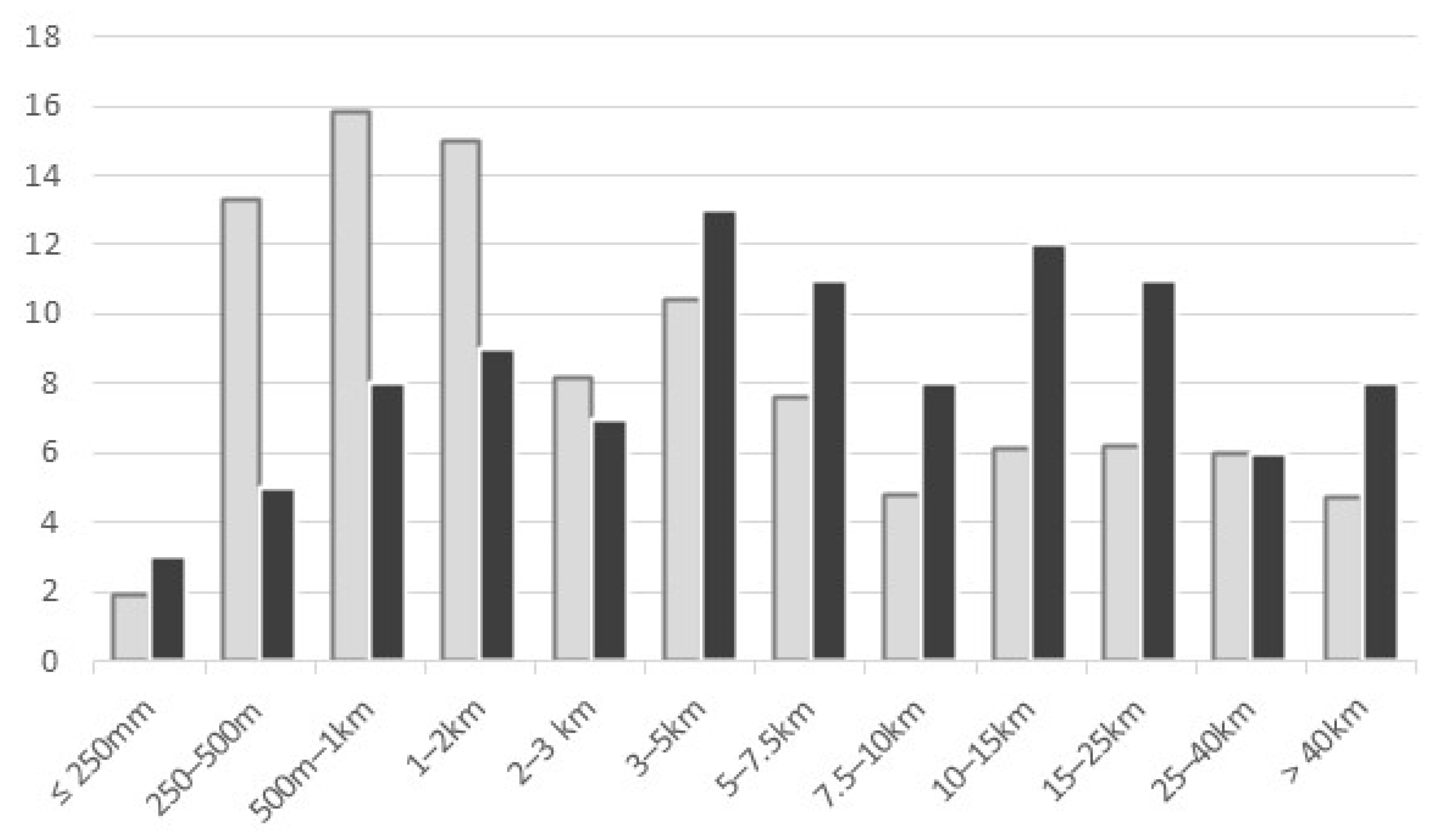
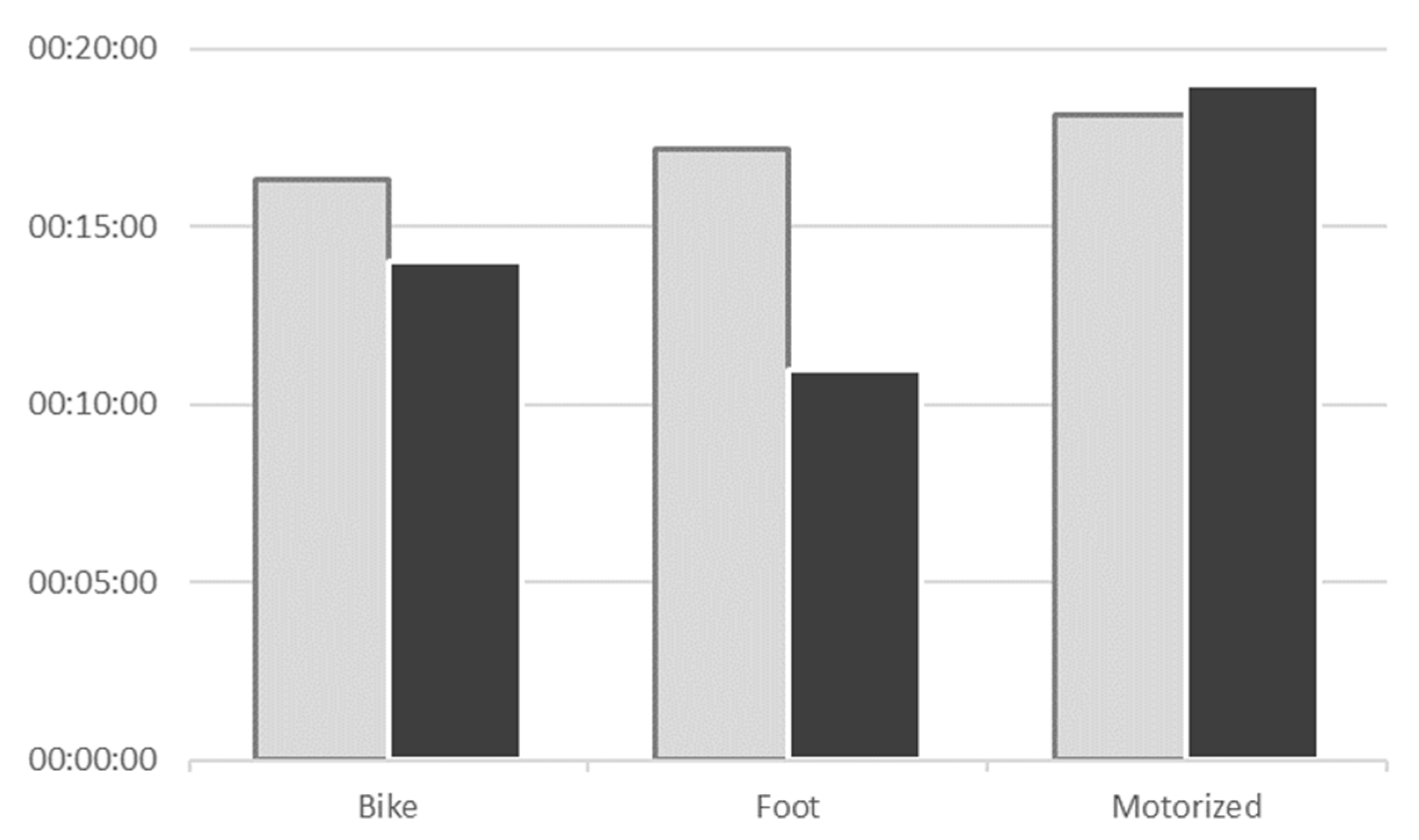
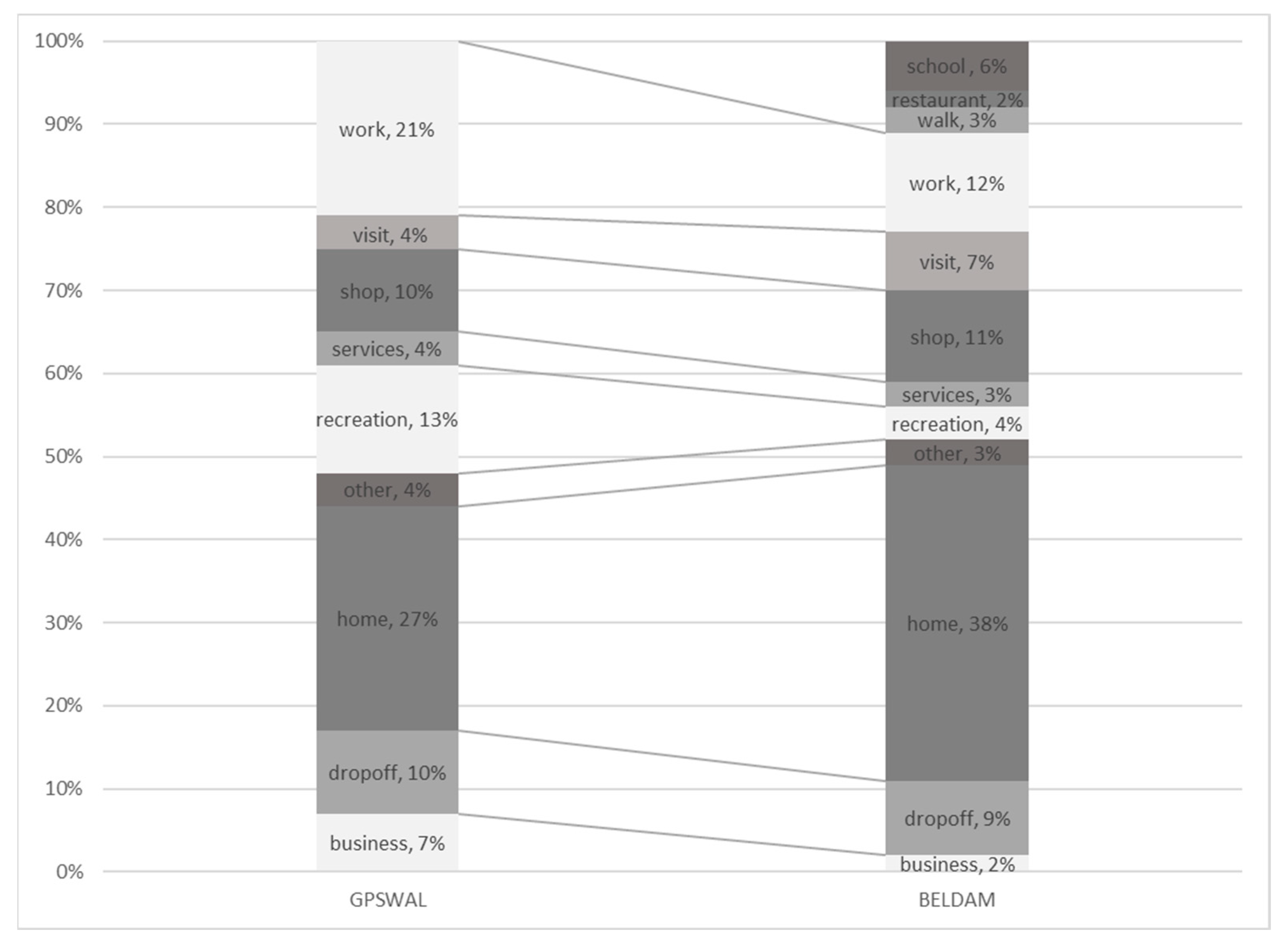

| Users | Trips | Trip Legs | Kilometers | |
|---|---|---|---|---|
| Official survey period | 237 | 10,395 | 14,047 | 121,008 |
| First campaign | 110 | 3689 | 4827 | 46,673 |
| Second campaign | 145 | 6709 | 9232 | 75,034 |
| Transport Mode | No Revisions | Revised | Total |
|---|---|---|---|
| Foot | 138 | 4 | 142 |
| Bike | 27 | 0 | 27 |
| Motorized | 562 | 7 | 569 |
| Unknown | 0 | 0 | 0 |
| Total | 727 | 11 | 738 |
| Transport mode | No Revisions | Revised | Total |
|---|---|---|---|
| Foot | 3477 | 962 | 4439 |
| Bike | 865 | 382 | 1247 |
| Motorized | 5972 | 1473 | 7445 |
| Unknown | 236 | 0 | 236 |
| Total | 10,550 | 2817 | 13,367 |
Disclaimer/Publisher’s Note: The statements, opinions and data contained in all publications are solely those of the individual author(s) and contributor(s) and not of MDPI and/or the editor(s). MDPI and/or the editor(s) disclaim responsibility for any injury to people or property resulting from any ideas, methods, instructions or products referred to in the content. |
© 2023 by the authors. Licensee MDPI, Basel, Switzerland. This article is an open access article distributed under the terms and conditions of the Creative Commons Attribution (CC BY) license (https://creativecommons.org/licenses/by/4.0/).
Share and Cite
Gillis, D.; Lopez, A.J.; Gautama, S. An Evaluation of Smartphone Tracking for Travel Behavior Studies. ISPRS Int. J. Geo-Inf. 2023, 12, 335. https://doi.org/10.3390/ijgi12080335
Gillis D, Lopez AJ, Gautama S. An Evaluation of Smartphone Tracking for Travel Behavior Studies. ISPRS International Journal of Geo-Information. 2023; 12(8):335. https://doi.org/10.3390/ijgi12080335
Chicago/Turabian StyleGillis, Dominique, Angel J. Lopez, and Sidharta Gautama. 2023. "An Evaluation of Smartphone Tracking for Travel Behavior Studies" ISPRS International Journal of Geo-Information 12, no. 8: 335. https://doi.org/10.3390/ijgi12080335
APA StyleGillis, D., Lopez, A. J., & Gautama, S. (2023). An Evaluation of Smartphone Tracking for Travel Behavior Studies. ISPRS International Journal of Geo-Information, 12(8), 335. https://doi.org/10.3390/ijgi12080335





